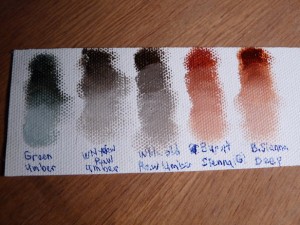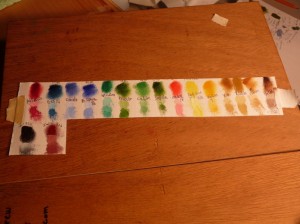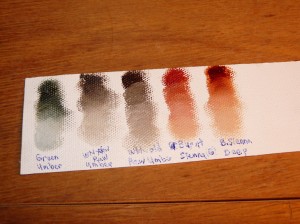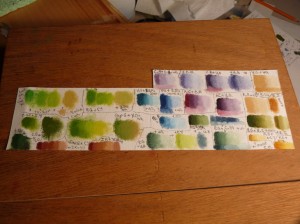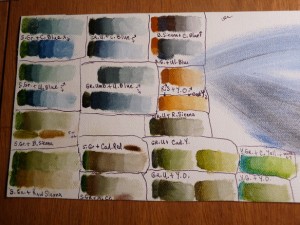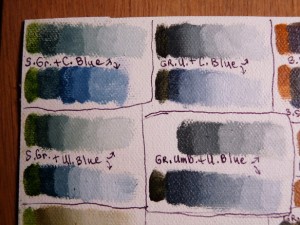I always advise students when they are starting out painting with watercolors or oils, to take each color they have and do color studies. If you keep them small, they are great (especially for beginners) to carry with you while you work to check what color’s would be good choices to use. It’s a little different for oils than watercolors as you want to add white to make tints of a color. Sometimes when you mix a color and it’s dark, you can tell a lot about it by adding a bit of white to some of it, it helps you ‘read’ the color better.
Here’s a few definitions for you:
- “Tint” is a color with white added.
- “Shade” is a color with black added.
- “Chroma” is the brightness or dullness of a color.
- “Value” is the lightness or darkness of a color.
- “Hue” is the color name, as in red, blue, yellow etc.
Now though I’ve been oil painting for years, I still find it helpful, when I’m away from it for a time, to do color studies to warm up and re-familiarize myself with the colors and their properties. (I get involved with my watercolors and set the oils aside sometimes for too long!) It’s also advisable to do when you purchase new colors.
The first thing you’ll want to do is make color tints with white. Take some canvas paper and try to plan out how you’ll group your colors together, probably blues, greens, reds, yellows, browns and black. This one is on a scrap piece of canvas paper; I started then added a few I forgot, so it’s not perfectly arranged. I created this one when I was in England and didn’t have many of my paints around.
Just use your brush to put a bit of one color down in a rectangle shape then pick up some white and add it to the color leaving some alone at the end. Wipe your brush off and pick up more white and dab it on, mixing it in leaving the area you just did alone, basically your adding more white progressively to lighten it. OR you can mix it on your palette using a palette knife and adding white to a bit of color, then take a dab of that new tint and start a ‘new’ mix and add more white to it; you’ll get progressively whiter mixes.
Clean your brush well between colors, when switching to a new color group (reds to greens etc.) use a new brush.
I added a few new ones to the back last night, I also ALWAYS label the color and an initial if you want, of the brand name.
Now that you have color tints, lay them aside to dry for several days and get some more canvas paper to play with color mixes. Here are pictures of studies I did at two different times.
This one is a little helter skelter as I didn’t plan out too much! I abbreviated the color names so I could understand what they were. I tried typical mixes, taking one color and adding different kinds of yellows to it, or blues etc. My main goal was to eliminate colors in my field kit that were similar or could be gotten easily by mixing. I always try to keep my backpack as light as I can.
Here I took two different reds, Alizarin Crimson and Cadmium Red, which I added Ultramarine Blue and then Cobalt Blue to, in varying amounts, then added white to really show the differences in them.
I did the same with three greens, Cad. Green, Prussian Green and Sap Green, to which I added Cad. Yellow and Yellow Ochre.
On this scrap piece of canvas paper I was mixing Sap Green with blues and also Raw Sienna; and excited to play around with my Green Umber, a darker, duller green but lovely! I also tested the Raw Sienna and Burnt Sienna with some blues, because the sienna’s are a orangy color, they yeild various greys with the blues.
Well get your oils out and get busy! Sometimes playing around with color mixes is a great thing to do in between paintings, when you don’t have time or inclination (inspiration) to work on a piece.
